Interact with the real-time data that created this report on the Dune Analytics dashboard.
Key Insights
- With over 12,000 daily active users, Decentral Games is more active than most decentralized metaverses.
- Decentral Games operates on the Polygon blockchain and is integrated within the Polygon Studios gaming and NFT ecosystem.
- ICE Poker is the main game in the Decentral Games ecosystem. It earned $36 million in Q1 2022 from NFT activations, NFT mints, secondary sales fees, and in-game upgrades fees.
- Important governance decisions made in Q1 2022 include adding in-game ads, featuring NFT mints in ICE, the native in-game currency, instead of ETH, and changing in-game reward distributions.
- The forthcoming launch of a simplified game mode via mobile app is expected to further increase the game’s user base.
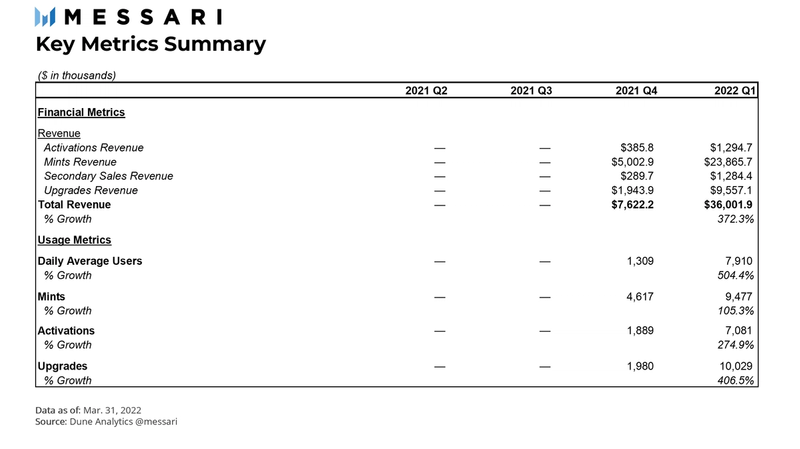
Poker rooms typically make their revenue from commission fees called a rake. It’s the cost of doing business, but there’s usually still some disgruntlement by players about this; after all, the operator is effectively applying a tax on the game. So what about a poker room where a rake doesn’t need to be applied? Or even, what about a poker room where players don’t have to lose anything at all?
Decentral Games in a Nutshell
Decentral Games is a game operator within Decentraland, a 3-D browser-based world. It’s designed to reward users through a play-to-earn mechanism. Those who commit time to play the game are given the means to build a collection of assets worth real-world money. Both fungible and non-fungible assets are incorporated within Decentral Games — users can self-custody assets, earn yield-based rewards, and take ownership of their in-game items.
Underneath the hood, Decentral Games uses Polygon as its scaling solution. A multifaceted partnership exists between the two entities: Decentral Games deploys its games on the Polygon network and is a member of Polygon Studio’s ecosystem. The game platform also runs its own Polygon node.
The most successful game offered in the Decentral Games ecosystem is ICE Poker. It’s where the focus of the development team — and of this report — resides. ICE Poker was launched in October 2021 and is based on Texas hold’em, one of the most popular poker variations. Hold’em was chosen with the intent to bring in more users. ICE Poker aims to tap into an existing player pool by not requiring users to learn a new game. As a result, ICE Poker is among the most active and fastest-growing decentralized virtual worlds.
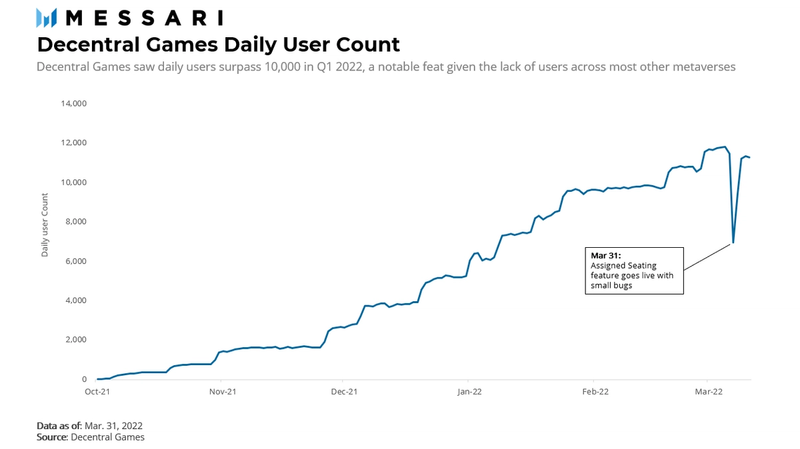
ICE Poker had approximately 8,000 daily active users in Q1 2022, up over 500% from the previous quarter. Not only did the ICE Poker game see a surge in users, the metric only reflects the average over the quarter and not the trend. The trend, meanwhile, highlights a steady increase in daily active users. Reaching 10,000 daily users for the first time in Q1 2022 is good evidence that ICE Poker is overcoming the usual lack of users that most decentralized metaverses face.
Notably, the last day of Q1 2022 did see a significant dip after reaching 12,000 daily active users before sharply rebounding in the beginning of April. This date coincided with the launch of a new feature, Assigned Seating, which launched with a few errant software bugs. Demand for Assigned Seating had been considerable, and after the bugs were fixed, daily users returned back to previous levels.
Wearable NFTs and Gameplay
To play ICE Poker, one needs to own or rent at least one in-game digital asset, i.e., a wearable NFT. Each wearable NFT starts as an ICE Rank 1 item (beginner) and can be upgraded up to ICE Rank 5 (colloquially known as diamond hand NFTs). Higher-ranked NFTs collect more rewards, which are paid out in ICE, the native in-game token. To move from one rank to another, owners must spend both ICE tokens and XP earned from completing gameplay challenges to level up their assets.
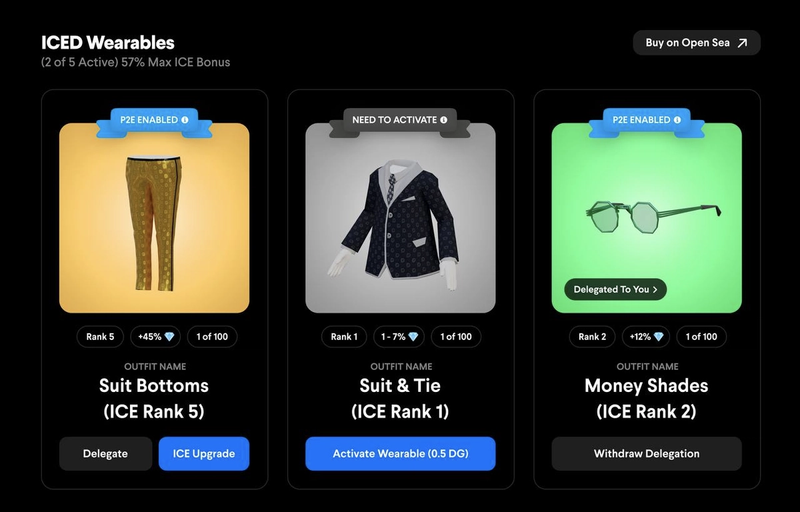
Source: Decentral Games
Players have the option of owning wearable NFTs outright (i.e., player-owner) or renting them (i.e., delegated player) from other NFT owners. Those with outright ownership may either acquire newly minted wearable NFTs or purchase them on secondary marketplaces like OpenSea (secondary sales). Ultimately, the decision remains a personal one. Poker players who are invested may want ownership of their own assets; meanwhile, metaverse “tourists” can choose to play without making any initial financial commitment. While delegated players face less risk, they have to split some of their earnings with the NFT owner.
Player Metrics and Rewards
Almost all games with in-game economies suffer from inflationary pressures. ICE Poker is no exception: as players spend more time in the game and rank higher on the leaderboard, they are more likely to receive greater ICE rewards. With ICE Poker finishing up its first full quarter, it’s worth tracking relevant in-game metrics. Let’s start by understanding the economic incentives for players first.
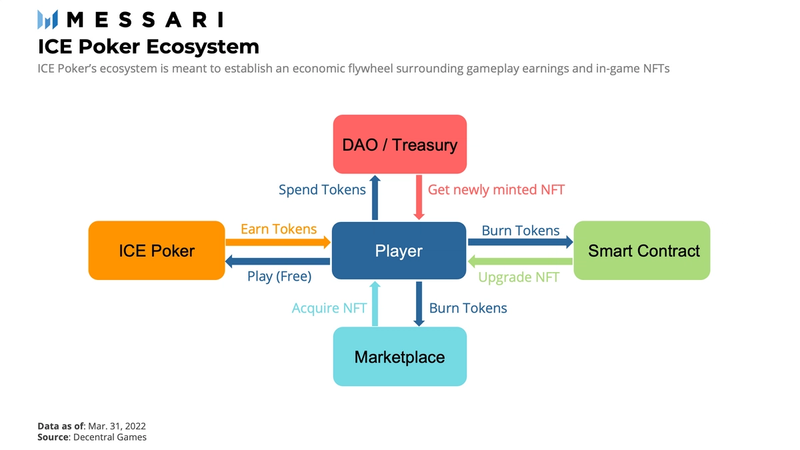
A visualization of the ecosystem’s economic engine is shown above. By accessing a wearable NFT, a player gets a daily allocation of chips. These chips can only be used for playing poker within ICE Poker. Notice players themselves don’t need to wager bets to play ICE Poker. Winning is measured in the number of ICE tokens earned. This essentially gives players a risk-free seat at the table: provided that players put the necessary time and effort into playing well, there is only upside potential. Each player is incentivized to perform a daily check-in, complete three daily challenges, and play well in exchange for ICE tokens and XP rewards. Gameplay rewards are calculated as follows:
- Based on each player’s ranking on the daily leaderboard, a performance multiplier is applied to their earnings, which are paid in ICE. The higher a player ranks, the higher their ICE earnings.
- Players may also get ICE based on their wearable NFTs. There are five different wearable NFT ranks, each with corresponding rewards.
- At the end of each month, players who are at the top of the leaderboard can earn additional DG tokens, granting them increased governance and fee share in the DG ecosystem.
Decentral Games incentivizes ICE Poker players to reinvest their gameplay rewards into their own wearable NFT portfolios. Acquiring NFTs by primary sales requires people to mint the NFTs upon release. As of April 28, 2022, there have been 12 drops of ICE wearable NFTs dating back to November 2021. Each NFT drop is pegged with an associated label: recent names have been ICE Cyberpunk, ICE Spartan, and ICE Poet. Labels primarily exist to distinguish when the NFT was minted and don’t have any impact on functionality.
By opting for a controlled NFT release schedule, Decentral Games believes its vertical progression is more sustainable than the burning-to-breed models of other games. Supply is actively managed without the risk of exponential growth. Notably, most mints are uniformly distributed among buyers, with 50% of new NFTs ending up in wallets with only one wearable. That number surges even higher to 91% when filtering for new mints ending up in wallets with two or fewer total wearables.
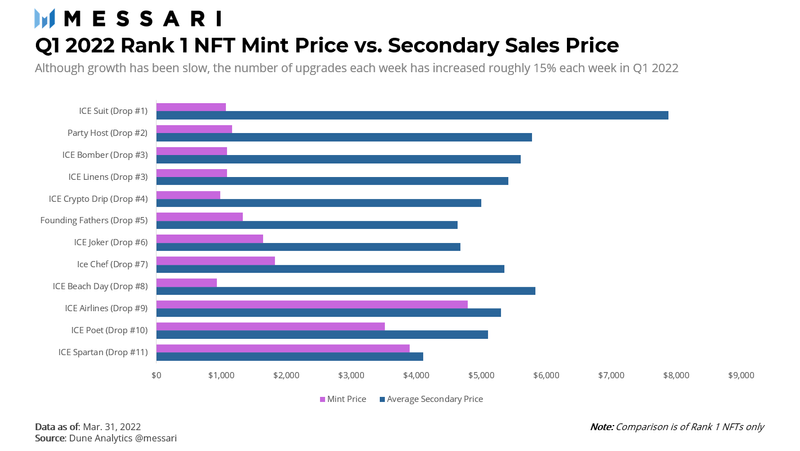
A study of mint prices compared to the secondary sales price shows an opportunity for users to make a quick buck. In each of the 11 NFT drops we analyzed, the average secondary sales price was higher than the mint price. However, recent mints have become more expensive. For example, the average mint price of the first eight NFT drops was $1,237, while the average price for the last three NFT drops was $4,070. The higher starting price cuts into the eventual profits from flipping on the secondary market and encourages minters to utilize the NFT for non-speculative purposes instead.
Poker Participants
After renting or purchasing at least one wearable NFT, any user is granted table access. And although users can choose to either rent or purchase their wearable NFTs to gain table access, the ICE Poker ecosystem gains more when users purchase their NFTs. To incentivize player-owners to invest more resources into the ecosystem, ICE Poker encourages its users to upgrade their wearable NFTs.

Notably, over the past months, it has become increasingly affordable for player-owners to upgrade their wearable NFTs. Although a higher ICE Rank still costs more to upgrade than a lower ICE Rank, the price gaps are starting to shrink. The lower prices may have incentivized player-owners to upgrade more often.

Indeed, the general price decrease of upgrades coincided with a weekly 15% increase in the number of upgrades in recent months. It may thus be fair to discuss what benefits upgrades bring to player-owners. One might hypothesize that upgrades may correspond to generally higher prices for rarer wearable NFTs — intuitively, Rank 5 wearable NFTs should be more expensive to acquire on secondary markets than, for instance, those of Rank 1.
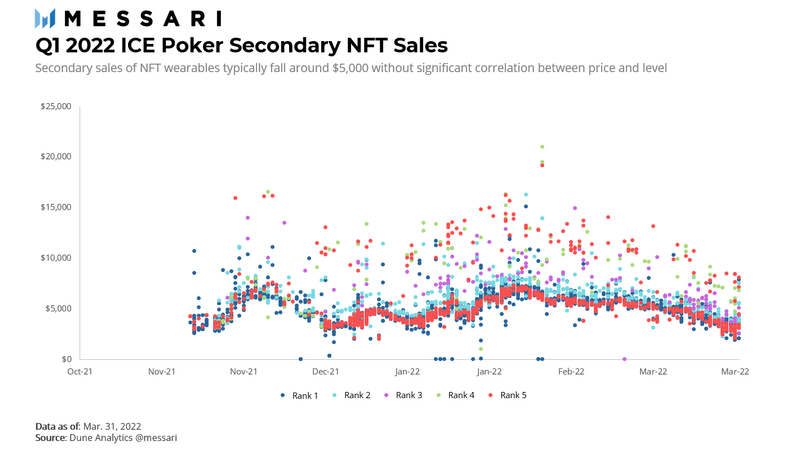
However, upon inspecting secondary sales prices, wearable NFT prices generally stabilize around the $5,000 range. On average, Rank 1 NFTs sold for the lowest prices, followed by Rank 5 NFTs. Conversely, NFTs of Ranks 3 and 4 sold for the highest prices. While this may be partly related to sample size, the behavior is still a surprising one.
Part of the explanation might be due to supply and demand. There were 3,487 sales of Rank 1 NFTs and 910 sales of Rank 5 NFTs in Q1 2022. Those volumes were multiples of the count for Rank 4 NFTs, which only had 79 transactions. Even Rank 3 NFTs only had 117 sales.
Another reason may be due to the gameplay itself. Purchasing a Rank 5 NFT could be seen as “cheating” the system; hardcore players might take this route to maximize reward, despite missing out on upgrade objectives. Altogether, there were 4,979 secondary sales in Q1 2022, which is significantly lower than the 9,477 total mints. These numbers suggest that there is not much selling activity — newly minted NFTs don’t usually change hands. Instead, player-owners are active poker players or have started to transition towards being guild owners who rent their wearable NFTs to other participants.
While gameplay requires a certain time investment, lending out wearable NFTs requires managing the performance of delegated players. The better those delegated players perform, the more revenue is accrued by a player-owner. Guild owners may find the second option attractive by choosing to delegate their guilds.
Guild Owners
ICE Poker enables guild owners to maximize their returns by tracking the performance of the delegated players via the Delegation Dashboard. Importantly, guilds don’t necessarily need to be wallets with dozens of NFTs; in the ICE poker ecosystem, a wallet with a single delegated NFT counts as a guild for the game’s tracking purposes.
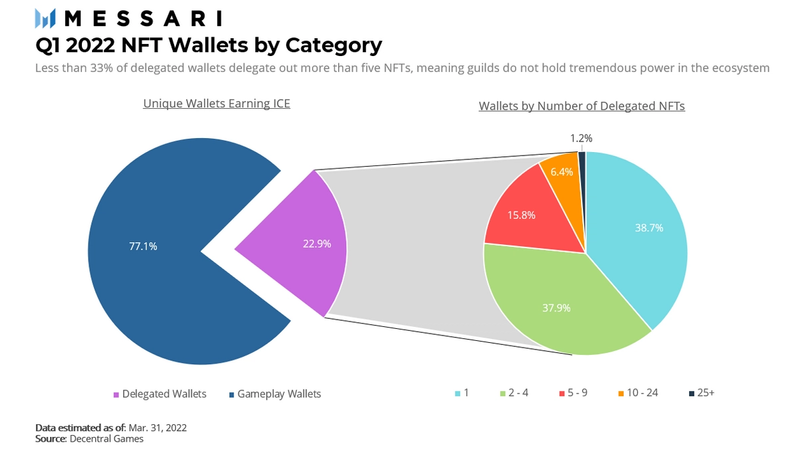
On-chain data shows there are more than 4,000 guild wallets, making up 23% of all ICE Poker NFT-owning wallets. Approximately 1,500 of those guild wallets delegate one wearable NFT; another 1,500 delegates out two to four; and 600 rent out five to nine wearables. The resulting 400 guilds manage more than 10 wearables.
This data confirms Decentral Games’ aim of ensuring the gameplay ecosystem remains healthy in the long term. In this sense, ICE Poker did not do any pre-sale over-the-counter deals for industry insiders. Instead, ICE Poker wearable NFT drops were designed with a wide distribution in mind to incentivize gamers instead of tokenholders. That is, the goal is to incentivize the 77% of gameplay wallets to acquire their in-game wearable NFTs through organic mints or secondary sales. In doing so, the revenues generated by ICE Poker can be better sustained.
ICE Poker In-Game Economy
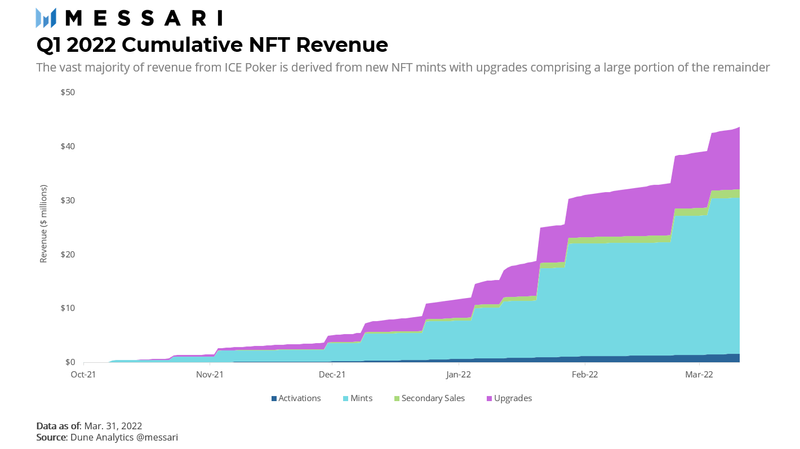
Approximately six months after the game’s launch, cumulative revenue from ICE Poker wearable NFTs reached over $40 million in Q1 2022. Minting accounts for the majority of ICE Poker revenue. In fact, almost 93% of ICE Poker revenue corresponds to mints and upgrades. The remaining 7% accounts for secondary sales and activations — this shows that only a small portion of revenues are accrued from the changing hands of wearable NFTs. Instead, once a wearable NFT is minted, most owners don’t sell them and prefer to use them in-game or rent them out.
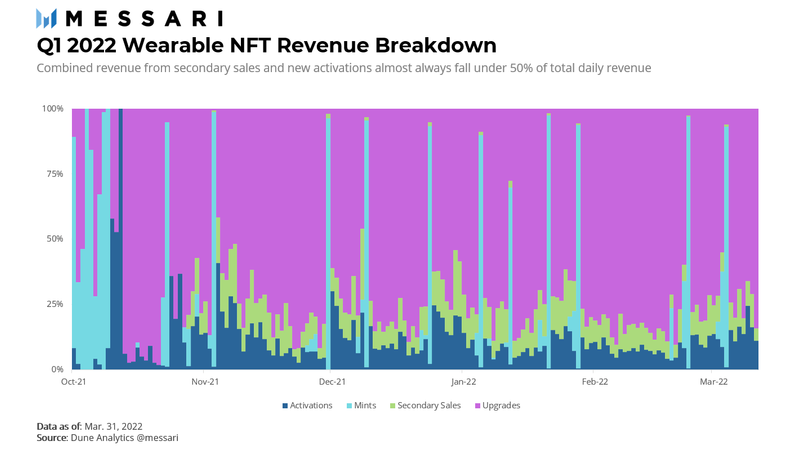
On a daily basis, mint revenue can be overrepresented on NFT drop days. Those particular days are vital for the protocol because revenue from mints comprises more than 70% of ICE Poker’s cumulative revenue. For days without mints, upgrades then make up the majority of daily revenue.
The remaining two revenue streams (secondary sales and activations) make up for only a small fraction of protocol revenue. Combined, they max out to 50% of daily revenue but typically fall around 25% or less. This upgrade-heavy revenue model hints toward a healthy in-game economy where users are incentivized to upgrade, instead of cashing out and passing on their wearable NFTs to the next player.
Holistically, ICE Poker’s monetization strategy is analogous to those perfected by high-growing consumer tech companies. The first step is user acquisition, which is where ICE Poker is today. Once users are brought into the product and scale is achieved, activations and secondary sales may potentially become more tangible sources of revenue — and not just any revenue, but a recurring revenue that yields higher valuations and protocol stability.
Governance Updates
The management of the DG lounge is mostly left up to stakers of the DG token. Governance participants can vote on the use of proceeds, whitelist logic, partnerships, gameplay factors (such as point multipliers), and more. The following is a series of approved governance decisions with high protocol impact:
Jan. 21, 2022 — Update ICE Poker Rewards Split to Incentivize Upgrades and Player Ownership
All delegated NFTs followed the same reward split prior to this governance decision: the delegator would receive 30% of the rewards while the player always earned 70% of the profits. Note this system ignores NFT rank. This governance decision changes that distribution. Voters believed owners should also earn a higher percentage of the reward since they bear the full cost of upgrading the NFT. The new split for wearable delegators will be as follows:
Rank 1 — 40%; Rank 2 — 43%; Rank 3 — 46%; Rank 4 — 49%; and Rank 5 (Diamond Hands) — 52%.
Feb. 5, 2022 — Allow Partnered Metaverse Advertised in ICE Poker Venues
A decision to approve advertisements (images, video, or audio) was made by governance at the beginning of February 2022. Advertisements are to be placed in strategic but non-intrusive locations within a few of the ICE Poker venues. The first location was the Stronghold venue, followed by the implementation of advertisements in the DEXT Lounge and Chateau Satoshi as well. Payment to Decentral Games will be made through stablecoins that will fund token buyback or LP revenue.
Feb. 6, 2022 — Lower Bars to Post and Pass a Proposal
Faced with high governance participation barriers, staked tokenholders voted to lower bars to post and pass proposals. Following the approved vote, the number of xDG needed to make a proposal fell from 1.9 million xDG to 10,000 xDG, increasing the count from 33 to 185 wallets that were eligible to make proposals. The quorum to approve decisions also fell from 38 million xDG to 10 million xDG, making proposals easier to pass.
Mar. 26, 2022 — Price the Next NFT Drop in ICE Tokens Instead of ETH
Ice Poker NFT Drop #8, the one titled ICE Beach Day, was priced in ICE tokens instead of ETH as a result of this governance vote. It was the first NFT drop to do so, and NFT Drop #10 (ICE Poet) was also priced in ICE. Denominating the sale in ICE encourages minters to purchase ICE and gives the protocol the ability to recalibrate token supply. Future mints will also likely be priced in either ETH or ICE.
Roadmap
To further expand the DG ecosystem, the development team has three core priorities for the upcoming quarter: solidify in-game tokenomics, improve the gameplay of ICE Poker, and launch a mobile-first application for on-the-go accessibility.
Solidify ICE Poker Game Economics
Any successful game design relies on sustainable in-game economics. If designed poorly, games face virtual inflation, which occurs when long-time players accumulate enough in-game capital to make purchases unattainable for new players. This inflation drives new players away from the game and slows the game’s growth.
This type of inflation is a relevant concern for ICE Poker. Balancing in-game currencies, NFT sales, and new mints necessitate game faucets to ensure that the issuance and burns are well-balanced. While this is an ongoing focus area, some ideas implemented by the team are higher stakes poker competitions, non-ICE NFT wearables, and custom NFT emotes.
Scale Gameplay of ICE Poker
Having previously experimented with various games, Decentral Games found poker to be the standout hit that attracted – and retained – users. A continued goal of the Decentral Games team, therefore, is to build out features designed to improve gameplay on ICE Poker.
For example, the team shipped the Assigned Seating feature which went live on March 31. It was put in place to stop players from choosing their specific seating at an active game. Since positioning is critical for a turn-based game like poker, this new feature reduces collusion opportunities between friendly parties. The development team plans to continue adding or tweaking elements to improve its game.
Inaugurate ICE Poker Mobile
A mobile version of ICE Poker is expected to be launched in Q2 2022. The on-the-go gameplay option will allow the team to attract new users and keep existing users engaged. The Decentral Games team has explicitly called this an important milestone to “onboard the next 30,000 players into the DG ecosystem.”
Based on public announcements, it seems that ICE Poker Mobile and the browser-based metaverse will share the same in-game currency and rewards mechanisms; however, ICE Poker Mobile will be an abbreviated 2-D version of the game. The result of that decision will be shorter gameplay times, lower entry costs, and smaller in-game rewards.
Closing Summary
If the metaverse is defined by anything, it’s by a surplus of ideas and a shortage of users. Even on the user front, emerging technologies might find an old adage to hold true: attracting users is easy; retaining users is hard. When people finally choose to explore virtual worlds out of curiosity, will they continue to come back to it, day after day, week after week?
The main takeaway for Decentral Games’ Q1 is straightforward. It’s still too early to make predictions, but their current ability to draw thousands of daily active users is impressive. A big part of that may be what they’re building (poker has historically been quite successful). Yet with continued design efforts, gameplay improvements, and a mobile app launching next quarter, Decentral Games and their ICE Poker metaverse are set up for continued near-term growth.
This report was commissioned by Decentral Games, a member of Protocol Services. All content was produced independently by the author(s) and does not necessarily reflect the opinions of Messari, Inc. or the organization that requested the report. Paid membership in Protocol Services does not influence editorial decisions or content. Author(s) may hold cryptocurrencies named in this report.
Crypto projects can commission independent research through Protocol Services. For more details or to join the program, contact ps@messari.io.
This report is meant for informational purposes only. It is not meant to serve as investment advice. You should conduct your own research, and consult an independent financial, tax, or legal advisor before making any investment decisions. The past performance of any asset is not indicative of future results. Please see our terms of use for more information.



















